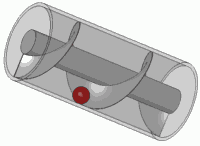Ready-mix concrete



Ready-mix concrete is concrete that is manufactured in a factory or batching plant, according to a set recipe, and then delivered to a work site, by truck mounted in–transit mixers. This results in a precise mixture, allowing specialty concrete mixtures to be developed and implemented on construction sites. The first ready-mix factory was built in the 1930s, but the industry did not begin to expand significantly until the 1980s, and it has continued to grow since then.
Ready-mix concrete is sometimes preferred over on-site concrete mixing because of the precision of the mixture and reduced work site confusion. However, using a pre-determined concrete mixture reduces flexibility, both in the supply chain and in the actual components of the concrete.
Ready-mix concrete is also referred as the customized concrete products for commercial purpose. Ready-mix concrete, or RMC as it is popularly called, refers to concrete that is specifically manufactured for delivery to the customer's construction site in a freshly mixed and plastic or unhardened state. Concrete itself is a mixture of Portland cement, water and aggregates comprising sand and gravel or crushed stone. In traditional work sites, each of these materials is procured separately and mixed in specified proportions at site to make concrete. Read-mix concrete is bought and sold by volume - usually expressed in cubic meters (cubic yards in the US).
Ready-mix concrete is manufactured under controlled operations and transported and placed at site using sophisticated equipment and methods. In 2011, there were 2,223 companies employing 72,924 workers that produced RMC in the United States.[1]
Disadvantages of ready-mix concrete
- The materials are batched at a central plant, and the mixing begins at that plant, so the traveling time from the plant to the site is critical over longer distances. Some sites are just too far away, though this is usually a commercial rather than a technical issue.
- Generation of additional road traffic. Furthermore, access roads and site access have to be able to carry the greater weight of the ready-mix truck plus load. (Green concrete is approx. 2.5 tonne per m³.) This problem can be overcome by utilizing so-called 'mini mix' companies which use smaller 4m³ capacity mixers able to reach more-restricted sites.
- Concrete's limited time span between mixing and curing means that ready-mix should be placed within 210 minutes of batching at the plant.[2] Modern admixtures can modify that time span precisely, however, so the amount and type of admixture added to the mix is very important.
Metered concrete
As an alternative to ready-mix concrete, volumetric mobile mixers may be used to provide metered concrete services. The volumetric mobile mixer is a truck that contains concrete ingredient materials and water to be mixed on the truck at the job site to make and deliver concrete according to the amount needed. The on-truck mixing at the job site eliminates the problems of ready-mix concrete such as delays that can cause the pre-mixed concrete to become unusable. This is a hybrid approach between ready-mix concrete and traditional on-site mixing.[3]
Standard ready-mix concrete vs. site-mix concrete
- A centralized concrete batching plant can serve a wide area. Site-mix trucks can serve an even larger area including remote locations that standard trucks can not.
- The plants are located in areas zoned for industrial use, and yet the delivery trucks can service residential districts or inner cities. Site-mix trucks have the same capabilities.
- Better quality concrete is produced. Site mix can produce higher compression strength with less water than standard batching methods.
See also
References
- Notes
- ↑ "Ready Mix Concrete Industry". PellResearch.com.
- ↑ ASTM C 94 and AASHTO M 157
- ↑ Casey, Jon M. "Parmer Metered Concrete offers precision and quality". Hard Hat News. Retrieved 24 November 2014.
- Bibliography
- Panarese, William C.; Kosmatka, Steven H.; Kerkhoff, Beatrix (2002). "10". Design and Control of Concrete Mixtures. Skokie, Illinois: Portland Cement Association. ISBN 0-89312-217-3.
External links
- National Ready Mixed Concrete Association
- Ready Mixed Concrete Manufacturer's Association
- European Ready Mixed Concrete Organisation
- Illinois Ready Mixed Concrete Association